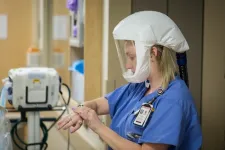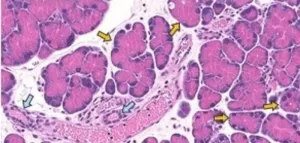(Press-News.org) Key Points:
C. difficile is one of the most common and contagious hospital-acquired infections.
Research has found that C. diff spreads more than three times more than previously thought.
C. diff can spread covertly from surface to surface and remain undetected for weeks until it infects a patient.
IMPACT: The results could spur more rigorous preventive measures that stop hidden spread of the disease.
One of the most common health care-associated infections spreads within intensive care units (ICUs) more than three times more than previously thought, new research has found.
Clostridium difficile infection—commonly called C. diff—causes diarrhea, abdominal pain, and fever and is lethal in about 6% of cases in the U.S. The disease is highly contagious, but in previous research, direct patient-to-patient transmission seemed to occur rarely. Now, by tracking the bacterium through the hospital environment, rather than on patients alone, scientists have uncovered previously undetected movement of C. diff bacteria through hospital settings.
“There's a lot going on under the hood that we're just not seeing,” says Michael Rubin, MD, PhD, epidemiologist and infectious diseases specialist in the Spencer Fox Eccles School of Medicine at the University of Utah and senior author on the study. “And if we ignore that, then we’re potentially putting patients at unnecessary risk.”
The results are published in JAMA Network Open.
Bacterial movement within the environment is common
To track infections throughout the health care setting, the researchers sampled for C. diff from nearly 200 patients across two intensive care units (ICUs), as well as collecting thousands of samples from hospital room surfaces and health care providers’ hands.
The researchers used whole genome DNA sequencing to precisely track bacterial movement. Different bacterial samples have genetic differences, which the researchers measured to track movement of C. diff around health care facilities. The team was even able to use these differences to determine if two bacterial samples came from the same patient, rather than being acquired independently from a source outside the hospital.
The team detected the bacteria in 10% of patient ICU stays—either on the patient’s body or in their immediate room environment. And in most of those cases, the bacteria were genetically identical to those found in another patient or another patient’s room, suggesting that the bacteria originated from the same patient rather than coming from two different sources.
“We find about the same amount of patient-to-patient transmission as previous studies,” explains Lindsay Keegan, PhD, research associate professor in epidemiology at U of U Health and first author on the study. “But what we find that’s novel is that there is a lot more movement of C. diff between surfaces, from surface-to-patient, and from patient-to-surface than previously found.”
Revealing long-term spread
By simultaneously tracking different bacterial varieties on patients, health care providers’ hands, and in the environment, the researchers uncovered cases of potential transmission that wouldn’t have been caught with other methods.
Notably, the team discovered that for more than half of potential transmission events, the two patients involved were never even in the hospital at the same time—sometimes being separated by weeks. The key to this paradox is the exceptional hardiness of C. diff: the bacteria can survive for a long time outside the body, withstanding common antibacterial measures such as alcohol-based cleansers. Bacteria from one person could be inadvertently transferred to surfaces in a different room, where they could lie in wait for another patient, undetected.
Importantly, not all C. diff bacteria cause disease, and most of the C. diff spread the researchers observed involved harmless bacterial varieties. However, the researchers say that the spread of non-disease-causing C. diff suggests that similar transmission of disease-causing C. diff could be going undetected.
How to prevent infection
The researchers say that they hope their results lead to stronger precautions to prevent the spread of disease within hospitals.
“What I'm hoping we get from this paper is that health care providers put a greater emphasis on infection prevention measures and adhere to them as much as they possibly can,” Rubin says. Using personal protective equipment such as gloves and gowns, as well as practicing rigorous hand hygiene, are crucial, he adds. “Those are the measures that can help interrupt this type of invisible transmission.”
###
The results published in JAMA Network Open as “Environmental and Health Care Personnel Sampling and Unobserved Clostridium difficile Transmission in ICU.”
The study was funded by the National Institutes of Health / National Institute of Allergy and Infectious Diseases grant 1K01AI159519 and the Centers for Disease Control and Prevention grants 5U01CK000585 and HHSD-200-2011-42039. The content is solely the responsibility of the authors and does not necessarily represent the official views of the National Institutes of Health.
Keegan reported receiving grants from the US Centers for Disease Control and Prevention (CDC) Center for Forecasting and Outbreak Analytics outside the submitted work. Karim Khader, PhD, reported receiving grants from the Department of Veterans Affairs (VA) and bioMerieux outside the submitted work. Rubin reported receiving grants from the CDC and the VA outside the submitted work.
END
Research uncovers hidden spread of one of the most common hospital-associated infections
2025-04-04
ELSE PRESS RELEASES FROM THIS DATE:
Many older adults send their doctors portal messages, but who pays?
2025-04-04
When today’s older adults were growing up, the only way to get information to your doctor or their clinic was a phone call. And getting more than a simple answer probably meant going in for an appointment.
But a new study suggests that people in their 50s and older have embraced the ability to send and receive secure medical messages with their doctors and other providers, through the digital patient portals that most health systems and medical offices now offer.
The study also suggests that some older adults – including those with very low incomes – find themselves getting billed for ...
Fine particulate matter from 2020 California wildfires and mental health–related emergency department visits
2025-04-04
About The Study: Wildfire smoke exposure was associated with significantly increased odds of subsequent emergency department visits for mental health conditions in this cross-sectional study, with varying lag times for different subconditions and demographic groups. Health care professionals and systems should prepare for a possible increase in demand for mental health–related emergency services during wildfire events.
Corresponding Author: To contact the corresponding author, Kari C. Nadeau, MD, PhD, email knadeau@hsph.harvard.edu.
To access the embargoed study: Visit our For The Media website at this link https://media.jamanetwork.com/
(doi:10.1001/jamanetworkopen.2025.3326)
Editor’s ...
Gender inequity in institutional leadership roles in US academic medical centers
2025-04-04
About The Study: This systematic scoping review suggests that even though emphasis has been placed on addressing gender inequities in academic medicine, considerable disparities remain at the leadership level. While certain positions and specialties have been observed to have more female leaders, niches of academic medicine almost or completely exclude women from their leadership ranks. Importantly, even female-dominated specialties, such as obstetrics and gynecology, have substantial inequity in leadership roles. It is past time for organizational and systems-level changes to ensure equitable ...
Pancreatic cells ‘remember’ epigenetic precancerous marks without genetic sequence mutations
2025-04-04
FOR IMMEDIATE RELEASE
Johns Hopkins Medicine scientists say they have found a pattern of so-called epigenetic “marks” in a transition state between normal and pancreatic cancer cells in mice, and that the normal cells may keep at least a temporary “memory” of those cancer-linked marks.
Epigenetic marks are chemical modifications that help regulate genetic expression without directly altering DNA sequence in the makeup of genes. While the genetic code is like a computer’s hardware, epigenetics involves chemical marks on top of the genetic code that act as software programing in a computer.
The ...
Rare combination of ovarian tumors found in one patient
2025-04-04
“This case underscores the rare coexistence of serous cystadenofibroma in one ovary and collision features involving serous and mucinous cysts in the contralateral ovary, a combination scarcely reported in the literature.”
BUFFALO, NY — April 4, 2025— A new case report was published in Oncoscience’s Volume 12 on March 31, 2025, titled “Cystadenofibroma and contralateral collision lesions: A unique ovarian case report.”
Authored by Dr. Naina Kumar and colleagues from the All India Institute of Medical Sciences, the report presents a highly unusual case involving two different types of benign ovarian tumors in ...
AI-driven clinical recommendations may aid physician decision making to improve quality of care
2025-04-04
Embargoed for release until 10:00 a.m. ET on Friday 4 April 2025
Embargoed Content from the Annals of Internal Medicine Breaking News Scientific Plenary at Internal Medicine 2025
Annals of Internal Medicine Tip Sheet
@Annalsofim
Below please find summaries of new articles that will be published in the next issue of Annals of Internal Medicine. The summaries are not intended to substitute for the full articles as a source of information. This information is under strict embargo and by taking it into possession, media representatives are committing to the terms of the embargo not only on their own behalf, ...
Artificial intelligence has potential to aid physician decisions during virtual urgent care
2025-04-04
Do physicians or artificial intelligence (AI) offer better treatment recommendations for patients examined through a virtual urgent care setting? A new Cedars-Sinai study shows physicians and AI models have distinct strengths.
The late-breaking study presented at the American College of Physicians Internal Medicine Meeting and published simultaneously in the Annals of Internal Medicine compared initial AI treatment recommendations to final recommendations of physicians who had access to the AI recommendations but may or ...
ACP and Annals of Internal Medicine present breaking scientific news at ACP’s Internal Medicine Meeting 2025
2025-04-04
ACP and Annals of Internal Medicine present breaking scientific news at ACP’s Internal Medicine Meeting 2025
Authors discuss research on AI in the exam room, switching GLP1-RAs for better glucose and weight control, and ACP’s best practice advice for the use of cannabis and cannabinoids for noncancer pain
NEW ORLEANS, April 4, 2025 – Today at the American College of Physicians (ACP) annual meeting, Internal Medicine Meeting 2025, in New Orleans, Annals of Internal Medicine presented three breaking scientific research articles during a live plenary session featuring the authors of those articles. The articles were published in ...
New study reveals polymers with flawed fillers boost heat transfer in plastics
2025-04-04
New Study Reveals Polymers with Flawed Fillers Boost Heat Transfer in Plastics
The UMass Amherst-led team challenges the conventional wisdom that perfect fillers are better for making thermally conductive polymers
AMHERST, Mass. — In the quest to design the next generation of materials for modern devices – ones that are lightweight, flexible and excellent at dissipating heat – a team of researchers led by the University of Massachusetts Amherst made a discovery: imperfection has its upsides.
This research, published in Science Advances, ...
Signs identified that precede sudden arrhythmic death syndrome in young people
2025-04-04
Milan, Italy – 4 April 2025. Recognising and detecting the signs that commonly precede sudden arrhythmic death syndrome (SADS) may help to prevent premature deaths, according to research presented today at ESC Preventive Cardiology 2025,1 a scientific congress of the European Society of Cardiology (ESC).
“SADS has not been well evaluated despite being one of the most common underlying causes of sudden cardiac death in young people, including young athletes,” said study author Dr. Matilda Frisk Torell of Sahlgrenska Academy - University of Gothenburg, Sweden. “We conducted an analysis of a large cohort of cases of sudden cardiac death in Sweden to ...



